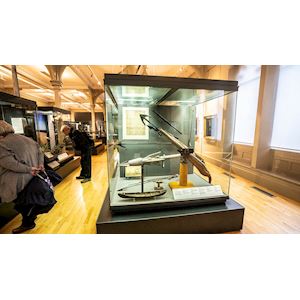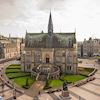
27. WHALING INDUSTRY – LINKS TO INUIT MATERIAL IN MAKING OF MODERN DUNDEE
In this display, you can see some of the city’s whaling material – recognized as a collection of national significance. Whaling was a major industry for the city for over 160 years. In 1754, Dundee’s first whaling ship sailed to the Arctic. Dundee ships continued to make this journey until 1914. Look at object numbers 1 and 2, which are bottles of whale oil. In the 18th century, whale oil was in high demand as a fuel for lighting. But by the mid 19th century it was replaced by coal and gas. Dundee had become Britain’s principal whaling port, but unlike other ports in Britain, Dundee had a different market for whale oil. The city’s jute industry used whale oil to facilitate the process of spinning. Many oil yards were built at Dundee’s port to support the whaling activity. The buildings are now gone, but whaling survives in names like Baffin Street and Whale Lane. Look at object number 8, which is a model of the whaling ship ‘Narwhal’. Dundee’s most productive and dominant period of whaling began in 1859, when the Dundee shipbuilders Alexander Stephen and Son built the first steam-powered whaler, the ‘Narwhal’. In 1867 Dundee had a whaling fleet of 12 full steam ships. While whaling was coming to an end at many other ports, Dundee’s fleet continued to grow, and by 1872 it was Britain’s leading whaling port. The captains and many of their crew were Dundonians. By 1885, whales in the Arctic seas were in short supply after so many years of intensive hunting. So, in 1892 four of Dundee’s ships set out south on an expedition to find whales in the Antarctic. The expedition was a failure. Not a single whale was caught. By 1914, the whaling industry in Dundee had ended.
To find out about the Famous Tay Whale, press the A button on your player, now or for the next stop on your tour, please find the case containing jute, at the back of the gallery underneath the rib cage of the whale skeleton.


The McManus: Dundee's Art Gallery and Museum
The McManus: Dundee’s Art Gallery and Museum is situated in the centre of Dundee. The Museum and Art Gallery originally known as the Albert Institute was opened in 1867 as a memorial to Prince Albert. In 2005 The McManus closed for a major refurbishment, reopening again on the 28th February 2010. We celebrated our 150th Anniversay in 2017 with a year of celebration. In 2020 we were awarded Visitor Attraction of the Year by Visit Scotland. The McManus has 8 galleries, which are laid out on 2 floors. Visitors can embark on a journey through 400 million years, and witness how a small settlement developed into the City of Dundee as it is today. From exhibits relating to the life of early man in the area, stunning paintings and decorative art through to artefacts from industries past and present, the City's collections, many of which are recognised as being of national significance, give an insight into Dundee and its people.
- The McManus: Dundee's Art Gallery and Museum
- Dundee United Kingdom
- www.mcmanus.co.uk
